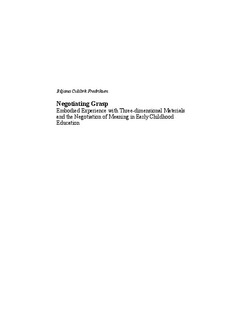| dc.description.abstract | Recent international acknowledgement of young children as competent active individuals raises questions about what their competences are, and what significance embodiment has for their learning. This thesis has two primary objectives: 1) to explore and clarify young children’s competences (ages 3-5), and 2) to uncover how children negotiate meaning through embodied experiences with physical and social environments. Building on the theories of John Dewey, Elliot Eisner and Arthur Efland, this thesis adopts an understanding that cognition is closely related to children’s experience with 3D-materials’ affordances and resistance. More specifically, this thesis examines what happens during aesthetic learning processes when children experience and explore materials’ affordances and resistance through art-based activities in early childhood educational contexts. This empirical, interactionist study was conducted in one Norwegian early childhood education centre, inspired by arts-based educational research and ART-ography. As such, the researcher gained access to the complex processes of children’s experiencing and expressing through interactions with children during visual art activities with 3D-materials. Two children took part in each of the activities and a total of nine educational contexts (cases) were filmed and analyzed. The data were analyzed using cross-case methods, and five selected cases were analyzed contextually. The software NVivo was used, and multiple case study methods were applied throughout the crosscase analysis.
The following four findings emerged from the cross-case analysis:
1. Through their embodied experiences and physical activities the children explored the 3D-materials’ qualities, simultaneously as they explored the possibilities of their own bodies.
2. The embodied experiences and verbal language mutually supported each other. The children connected earlier and new experiences through imagination and metaphor development, and negotiated personal meanings.
3. The materials’ resistance initiated problem-solving activities and engaged creativity. Unique solutions and new meanings emerged in form of micro-discoveries.
4. What was possible to learn was highly dependent on the quality of inter-subjective relations between the teacher and the children. The researcher’s choices of materials and tools structured what was possible to negotiate meanings about, but her attitudes (expressed though body language, tone of voice etc.) were as important. The close focus on children’s actions and expressions lead to an insight that negotiation of meaning is a complex process that interweaves material, individual, and social phenomena, and where imagination, creativity, and metaphor play essential roles. The contextual analysis uncovered materials’ resistance as a significant source of motivation to self-initiated problem solving. The thesis discusses young children’s imaginative connections between past and present experiences and suggests that their microdiscoveries are the essence of creativity. The findings in this thesis contribute to understanding children’s holistic learning strategies and exemplify how aesthetic experiences can support cognitive activities. The thesis promotes a holistic view on learning, but also problematizes the tensions between the embodied and linguistic nature of learning, which is a significant tension in many educational systems. It further suggests that the present international educational testing race demands extensive discussions about what quality of education is, how it is measured, and what quality of early childhood- and school education should be. | en |
